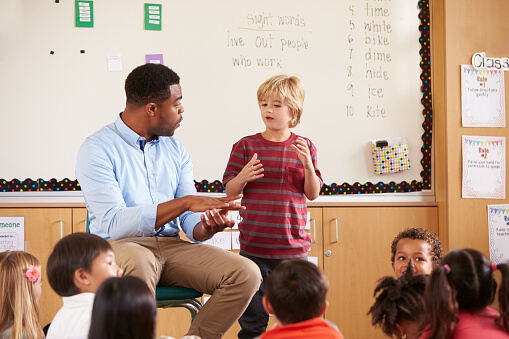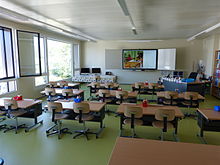
Special education requires special attention. This type of teaching requires the use of special physical and supplementary tools in a classroom setting. The goal of this type of teaching is to increase the educational opportunities for students who have specific needs. Depending on the circumstances, accommodations may include changes to the curriculum and supplemental aids or even physical adaptations. These accommodations allow students to have a positive learning experience and provide support for their emotional and physical needs.
Students with learning disabilities
A learning disability is a condition that prevents you from performing certain tasks. To achieve academic goals, students with learning disabilities might need special education services. The student cannot achieve the grade-level standard of achievement if the disability is severe enough. Other causes of disability, such visual or auditory impairment, mental retardation and cultural differences, are not acceptable.
Learning disabilities are relatively common among children, but are not equally distributed across racial groups. While learning disabilities are more common among boys than those in the girls' group, they are not caused by gender bias. Boys are also more likely be referred to special school because they are active and can have an impact on their academic performance.

Adapting a curriculum
Curriculum adaptation allows teachers to adapt their curriculum in a dynamic way that meets the needs of students with learning disabilities. This ensures every student has the chance to learn. Changes may include reducing the number of tasks a learner has to complete, increasing the time each lesson takes, or increasing the assistance provided by staff. Sometimes, teachers will change the content or method of instruction, too.
The best curriculum adaptations are student-specific. Teacher must determine the learning needs of each student and create tools to enable them to make effective curricular modifications.
Assistive Technology
Working with assistive technology can provide a number of benefits to learners with disabilities. It can enable these learners to be leaders in the classroom, take part in extracurricular activities, as well as foster a sense a camaraderie, amongst their peers. It can also help these students to build relationships with educators and develop self-confidence.
Assistive technology is an essential part of special education teaching. Technology selection should be based on the student's environment and needs. It is not sufficient to look for the most high-tech or the most expensive device. They should also consider the current skill level of the student, changes in the environment, and new technologies.

Funding issues
For many schools and districts, the lack of special education funding is a major problem. This funding shortage affects not only students with disabilities but also teachers and itinerant providers of services. Teachers and service providers must work harder to meet the needs of students if they don't have sufficient funding. Administrators have to find funding elsewhere, including budget cuts or local levies.
Unfortunately, this funding model is not working. It isn't fair or equitable. In addition, it has proved difficult to keep teachers in the classroom. A lack of funding has caused a high rate in teacher turnover which in turn hinders student growth. Teachers have spoken out in an effort to improve the situation.
FAQ
What is an alternative school?
The idea behind an alternative school is to offer students with learning difficulties access to education by providing them with support from qualified teachers who understand their individual needs.
An alternative school provides children with special educational needs the opportunity to learn in a regular classroom setting.
They are also provided with extra assistance when necessary.
Alternative schools do not exist for students who are exclusion from mainstream schools.
They are open for all children, regardless their ability or disability.
How do I select my major?
Students choose their majors depending on their interests. Students may choose to major in the subject they are most passionate about because it is easier than learning something else. Others want to pursue a career for which there are no jobs available. Others are motivated to make a living while studying a major. No matter your reasons for choosing a major, you should consider the type of job that you might be interested in after you graduate.
There are many ways you can find out more about different areas of study. Talk to your friends and family about their experiences in these fields. To find out if there are jobs available, you can read newspapers and magazines. Ask your guidance counselor about possible career options. Visit Career Services in your local library. Check out books related to various topics at your library. Use the Internet to find websites related to particular careers.
What's the difference between private and public schools?
All students can attend the public school for no cost. They provide education for students from kindergarten through highschool. Private schools charge tuition fees for each student. They provide education from preschool to college.
There are charter schools that are both privately operated and publicly funded. Charter schools do not follow the traditional curriculum. Instead, charter schools give their students more freedom in learning what interests them.
Charter schools are popular among parents who believe their children should have access to quality education regardless of financial status.
How do you get scholarships?
Scholarships are grants to help with college expenses. There are many kinds of scholarships. These are:
-
Federal Grants
-
State Grants
-
Student Loans
-
Work Study Programs
-
Financial Aid
Federal grants are directly issued by the U.S. government. Federal grants usually require applicants to meet specific requirements. To demonstrate financial need, applicants must meet certain requirements.
Individual states can offer grants to state governments. These funds are offered by individual states based on financial need. Others offer money for specific purposes.
Banks and other lending agencies can provide student loans. Students borrow money to pay tuition and other living expenses.
Work-study programs are designed to encourage employers to hire qualified students. Employers must pay workers at least minimum wage.
Financial aid allows low-income families to afford college by paying for all or part of their tuition costs.
Which factors are important when selecting a major
The first step is to decide whether you prefer to enter a particular profession straight away or attend college. First, make a list about your interests and talents. Reading, listening to music and talking to people are all possible interests. Your talents can come from singing, dancing, drawing, painting, writing, sewing, cooking, woodworking, gardening, photography, carpentry, auto mechanics, plumbing, electrical wiring, computer programming, accounting, mathematics, chemistry, physics, engineering, medicine, dentistry, nursing, psychology, law, social work, teaching, etc. You can use your interests and talents to help you select a major.
If you're interested in becoming an artist, you might be drawn to art history or fine arts. If you love animals, biology might appeal to you. Pre-medicine or medical technology may be an option for you if your dream is to become a physician. Computer science or computer networking is a great career choice for someone who wants to work in computers. There are many options. You just need to think about what you would like to do.
Statistics
- Data from the Department of Education reveal that, among 2008 college graduates, 92.8 percent of humanities majors have voted at least once since finishing school. (bostonreview.net)
- Among STEM majors, that number is 83.5 percent. (bostonreview.net)
- They are also 25% more likely to graduate from high school and have higher math and reading scores, with fewer behavioral problems,” according to research at the University of Tennessee. (habitatbroward.org)
- In most developed countries, a high proportion of the population (up to 50%) now enters higher education at some time in their lives. (en.wikipedia.org)
- And, within ten years of graduation, 44.1 percent of 1993 humanities graduates had written to public officials, compared to 30.1 percent of STEM majors. (bostonreview.net)
External Links
How To
Why homeschool?
There are many things to take into consideration when making the decision to homeschool your child or send him to school.
-
Which type of education do YOU want for your child's future? Are you looking for academic excellence, or social skills?
-
How involved are you in your child’s education? Are you interested in keeping up with what your child does? Would you rather keep your child informed?
-
Is your child a special needs child? Is your child a special needs child?
-
Will you be able to manage your child's schedule? Will you be able to teach your child every day at home?
-
What topics will you cover? Math, science, language arts, art, music, history, geography, etc. ?
-
How much money do you have available to educate your child?
-
Is your child able to go to school?
-
What is the best place to house your child? This includes finding space large enough to house your child, as well providing facilities such as bathrooms and kitchens.
-
What is your child’s age?
-
When does your child go to bed?
-
When does he/she finally wake up?
-
What is the time it takes to get from point A and point B?
-
Is your child's primary school close to you?
-
What is the distance between your home and your child's school?
-
How will your child get to and from school?
-
What are some of these benefits?
-
What are the downsides?
-
Who will watch your child while he/she's outside?
-
What are you expecting from your child's education?
-
What kind of discipline will you use?
-
What curriculum will your school use?
There are many reasons why people decide to homeschool their children. Some of these reasons are:
-
Your child might have learning disabilities that make it difficult for him/her to attend traditional schools.
-
You are interested in providing an alternative type of education for the child.
-
You would like more flexibility with your scheduling.
-
Avoid high tuition fees
-
You believe your child is receiving a better quality of education than he/she could receive in a traditional school environment.
-
You believe you can teach your children better than any teacher in a traditional school setting.
-
You don't like the way the school system works.
-
You feel uncomfortable with the rules and regulations of the school system.
-
You want your child's work ethic to be strong.
-
You want to give your child the freedom to choose what courses you take.
-
You want individualized attention for your child.
Some other benefits of homeschooling include:
-
There are no worries about uniforms or books, pencils, papers, or other supplies.
-
Your child can be educated according to their interests.
-
Homeschooling allows parents to spend quality time with their kids.
-
Students who have been homeschooled learn better because they're not distracted by peers.
-
Homeschoolers score higher on standardized exams.
-
Homeschool families tend to be happier overall.
-
Homeschool students are less likely drop out of school.